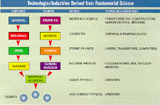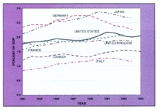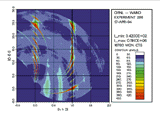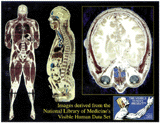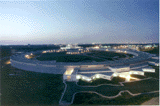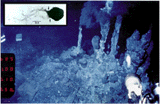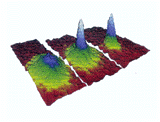![]()
|
SCIENCE: THE ENDLESS RESOURCE
Underpinning Our Nation's Economic Well-Being, Health, and National Security "Cutting back on research at the dawn of a new century where research is more important than it has been for even the last fifty years would be like cutting our defense budget at the height of the Cold War."
Throughout time, humans have pondered the nature of the universe and the laws that order it, seeking to understand our world and our place in the cosmos. Curiosity and the quest for understanding punctuate all human growth and learning, beginning with our childhood questions: "What is it?" "How does it work?" "What happens if . . . ?" Basic (or fundamental) research seeks to answer these and other questions in all scientific fields. Basic research usually does not have a specific practical benefit in mi nd; it simply helps us understand the way things are and generates new ideas and questions about the unknown. It has taught us about the evolution of the physical universe, the evolution of life, and a wealth of other topics.
OUR NATIONAL GOALS FOR SCIENCE
To advance America's interests in science, mathematics, and engineering, the Administration set forth the following goals in its 1994 science policy statement, Science in the National Interest:
SUSTAINING LEADERSHIP ACROSS THE
Leadership across the frontiers of scientific knowledge is not merely a cultural tradition of our nation - today it is an economic and security imperative. Creative people working in diverse fields generate new knowledge - rich in wonder and often leading
to unexpected applications. The range of our research spans all major fields of science and engineering and is one of its most powerful attributes.
Given the growing linkages among the scientific and technical disciplines, it is impossible to predict what expertise will be indispensable for future developments. As with any investment portfolio, certain areas will be emphasized at any given time becau
se of special opportunities for progress and impact. The Federal portfolio, however, must remain broad-based and accommodate the high-risk investments that may have enormous long-term impact. It is increasingly evident that the major fields of science a
nd engineering mutually catalyze one another - strengthening the fabric of science and, with it, the entire science and technology enterprise. By advancing all frontiers of knowledge, creative American scientists and engineers, along with their students,
enrich the present and shape the future.
|
|
|
|
In each of the last four years, American scientists funded by the U.S. government have won Nobel prizes. These awards reflect the enormous dividends of specific research investments included years ago in our national research and development portfolio by
the National Science Foundation, the National Institutes of Health, the Department of Energy, and the Department of Defense.
|
|
|
|
|
|
NOBEL PRIZE IN PHYSICS awarded to:
NOBEL PRIZE IN CHEMISTRY awarded for contributions to the developments of
NOBEL PRIZE IN PHYSIOLOGY OR MEDICINE awarded jointly to:
BANK OF SWEDEN PRIZE IN ECONOMIC SCIENCES IN MEMORY OF ALFRED NOBEL awarded jointly to:
|
|
|
|
NOBEL PRIZE IN PHYSICS awarded for pioneering contributions to the development of
NOBEL PRIZE IN CHEMISTRY awarded to:
NOBEL PRIZE IN PHYSIOLOGY OR MEDICINE awarded jointly to:
BANK OF SWEDEN PRIZE IN ECONOMIC SCIENCES IN MEMORY OF ALFRED NOBEL awarded jointly to:
|
|
|
|
NOBEL PRIZE IN PHYSICS awarded for pioneering experimental contributions to lepton
NOBEL PRIZE IN CHEMISTRY awarded jointly to:
NOBEL PRIZE IN PHYSIOLOGY OR MEDICINE awarded jointly to:
BANK OF SWEDEN PRIZE IN ECONOMIC SCIENCES IN MEMORY OF ALFRED NOBEL awarded to:
|
|
|
|
NOBEL PRIZE IN PHYSICS awarded jointly to:
NOBEL PRIZE IN CHEMISTRY awarded jointly to:
NOBEL PRIZE IN PHYSIOLOGY OR MEDICINE awarded jointly to:
BANK OF SWEDEN PRIZE IN ECONOMIC SCIENCES IN MEMORY OF ALFRED NOBEL awarded to:
|
|
ADVANCING THE FRONTIERS
Maintaining U.S. leadership across the frontiers of scientific knowledge is achieved through investments by numerous Federal agencies that span all fields of science and engineering. Diverse combinations of expertise and approaches, along with teamwork an
d collaboration, contribute to the steady progress and major breakthroughs advancing today's frontiers. By bringing specialists together to tackle problems that transcend disciplinary boundaries, we cross-fertilize scientific fields and spur further advan
ces.
Each theme listed below represents an area of emphasis in our Federal research portfolio:
At present, scientists can claim a rudimentary understanding of the physical evolution of the universe from about 10-35 seconds after the start of the Big Bang to today. Recent discoveries by space-based instruments, such as the Hubble Space Telescope, by NSF's ground-based observatories, and by a new generation of large privately funded telescopes, have made recent years outstanding ones for astronomy.
|
|
LEARNING HOW TO ENSURE
Because of both natural and manmade causes, our earth undergoes local, regional, and global changes on time scales ranging from momentary to geological. Humans and other creatures affect earth's habitability by just living. In fact, over eons, photosynthe
sis by early plants on the ancient earth created the oxygen-rich atmosphere we and other animals breathe. Now, to maintain our high standard of living we convert vast quantities of energy and raw materials into forms we desire, consume, and often discard.
This consumption has adverse effects on the earth's air, water, weather, landforms, and agricultural productivity. The U.S. Global Change Research Program coordinates the efforts and invest
ments of 13 Federal agencies and collaborates with international partners to study these problems.
|
|
DESIGNING MATERIALS FOR BUILDING
From the ancient Bronze and Iron Ages to the Information or Silicon Age of today, materials have been at the heart of technological revolutions. Advances in communications, computers, medicine, transportation, energy, and defense technology are all made p
ossible by new materials and materials-related phenomena.
The human genome is the complete set of genetic instructions found in the nucleus of most cells on 23 pairs of chromosomes that are long strands of DNA. Each gene is a segment of DNA that carries the blueprints for a specific molecule, usually a protein.
When there is a mistake in the order of chemical bases that comprise the DNA coding for a specific protein, that protein may be altered, missing, or ineffective in the family members carrying the error. The methods for locating such disease genes include
the construction of detailed maps to identify the position of the gene on a chromosome, sequencing the DNA in the area where the gene is localized, and comparing the gene sequence in individuals who have the disease with those who do not. For a newly isol
ated gene, the researcher can quickly gather from on-line databases everything that has already been determined about its identity, function, and protein product.
The current revolution in information and communications technologies is creating demands for new human learning skills and interaction modes. Merely being able to read, write, and calculate is no longer sufficient. Everyone needs to master the skills req
uired to extract and integrate relevant information and use it for complex decision-making and problem-solving.
|
|
INVESTING IN MODERN SCIENTIFIC
Just as Olympic-caliber athletes need the finest equipment and training protocols to triumph in their events, so do scientists, engineers, and their students need the most modern research instruments and facilities with the best capabilities, the farthest
reach, and the finest accuracy and resolution. As we push beyond the frontiers of our current knowledge, research facilities, instruments, and enormous databases serving the social sciences must evolve to support ever more complex research. These major f
acilities and laboratory tools require continuous modernization, upgrading, and, ultimately, replacement.
|
|
National Nanofabrication Users Network (Nodes in California; New York; Pennsylvania; Washington, D.C.); operational in 1994. Network providing electronic access to fabrication equipment
and expertise on nanoscale materials and devices.
|
|
Advanced Light Source (California); completed in 1994. Provides soft x-ray beams.
|
|
PARTNERING TO ADVANCE
Within the United States, many players sharing common goals in these times of constrained resources are partnering to sponsor or pursue research programs in their area of mutual interest. The Administration has enthusiastically encouraged and supported re
search partnerships of all types. Such collaborations combine the resources of industry, academia, nonprofit organizations, and all levels of government to advance knowledge, promote education, strengthen institutions, and develop human resources.
UNIVERSITY-GOVERNMENT PARTNERSHIPS
The compact between government and universities aimed at advancing science and technology in the national interest goes back well over a century, when the Land Grant universities were founded. In the last 50 years, this partnership has become the core of
our world-class science and technology enterprise. Over half of the Federal investment in basic research goes to universities, where it supports the training of young scientists and engineers and the creation of new knowledge.
|
|
PERSONNEL EXCHANGE PARTNERSHIPS
Exchange of personnel is probably the most effective vehicle for transferring research results among institutions and disciplines and converting them into products and markets. Graduate student and post-doctoral fellowship programs bring bright young peop
le from universities into national laboratories. Faculty exchanges bring industrial or national laboratory scientists and engineers into universities, while faculty members move into industry or Federal laboratories. The NSF's Grant Opportunities for Academic Liaison with Industry, for example, stimulates a mix of industry/university linkages. This initiative targets high-risk, high-gain fundamental research; developmen
t of innovative, collaborative industry/ university educational programs; and direct transfer of new knowledge between universities and industry.
PARTNERSHIP PROJECTS
Partnerships are also a means for building scientific instrumentation and facilities. Increasingly, the Federal government is providing the resources to build major new scientific user facilities, and other partners are sponsoring and developing user-rese
arch stations. In other cases, the entire research device comes into being only with the combined support of state and local government, industry, private foundations, universities, and the Federal government, none of which individually could shoulder the
entire burden. The Administration has actively promoted innovative investment partnerships that collect the required resources from several sources to develop leading scientific capability. A few recent examples include:
The Federal role in forging research partnerships to enhance U.S. competitiveness or economic development is well proven. Numerous examples exist, where a small amount of federal seed money has created partnerships that can grow to thrive without further federal resources. For example, NSF's Industry/University Cooperative Research Centers, and its St ate/Industry/University Cooperative Research Centers encourage highly leveraged cooperation among the indicated players on research topics of interest both to industry and the university. Within five years, full support of such centers must come from the non-federal partners. The DOD Government/ Industry/University Cooperative Research Program promotes the creation of a knowledge base to enhance national security and domestic economic growth. The program capitalizes on co-funding by industry and go vernment of university research centers to conduct long-term, goal-oriented research in areas of mutual interest. The Sea Grant and National Estuarine Research Reserv e programs of DOC/NOAA leverage Federal resources by requiring state matching funds and encouraging partnerships with industry.
|
|
INTERNATIONAL PARTNERSHIPS IN FUNDAMENTAL SCIENCE
In many research fields the path to scientific advances increasingly involves international collaboration. International partnerships allow us to pursue important elements of our research agenda, even when financial, human, infrastructure, or other facto
rs are limiting. For nearly 40 years, scientific activities in Antarctica have been inherently international, with the United States assuming leadership responsibilities in some arenas, and relying on other nations for hospitality and support elsewhere. S
ome major research endeavors, such as space missions, giant particle accelerators, astronomical observatories, the quest for fusion energy, and mapping the human genome, are so resource intensive and necessarily one-of-a-kind that international cost-shari
ng, exchanges, or in-kind contributions have become commonplace. Recent examples include NSF's Gemini Telescopes and several detectors for DOE's high-energy and nuclear physics facilities. Collaborations with individual investigators in other countries, occasional use of specialized foreign apparatus, multi-year international experiments, and participatio
n in facility or device development and construction routinely make state-of-the-art capabilities in other countries available to American scientists and their students, and vice versa.
OUR COMMITMENT This Administration has a policy of protecting Federal investments in basic research across all major scientific fields. These investments are essential to our strategy for reaching our overarching national goals. It is impossible to predict which areas o f science and engineering will yield ground-breaking discoveries, what those discoveries will be, or how they will impact other disciplines and, eventually, our daily lives. Who can foretell what will be needed to maintain our national security and our st rong economy, and to clean up the environment and develop a healthier, better-educated citizenry? By sustaining our investments in basic research, we ensure that America remains at the forefront of scientific capability, thereby enhancing our ability to shape and improve the world's future. |
|
In a stunning scientific advance that contributes to our fundamental understanding of the origin of life, in August 1996 a team of researchers announced that they had decoded the first complete genetic blueprint of a microorganism from the third major bra
nch of life on earth. The finding will allow scientists to understand more about the operation and function of the cell, while bringing them closer to understanding the nature of the ancestral cells from which life stemmed early in the planet's history. I
n the years ahead, the sequence holds dramatic prospects for commercial applications in biotechnology, development of renewable energy sources, and for cleaning up the environment.
|
|
|
|
For a few seconds in June 1995, several thousand rubidium atoms coalesced inside a tiny glass vial in a laboratory in Boulder, Colorado. As rapt scientists observed the fleeting video image of a gassy super-cooled blob of molecules, a state of matter neve
r observed before joined the ranks of physical wonders. The short-lived phenomenon elegantly established a long-standing but elusive hypothesis and opened an uncharted realm of scientific research that may prove as significant as the discovery of the lase
r to industry and society.
|
|
|
|
The hopeful notion that worlds exist around other stars yielded to wonderful fact in 1995 and 1996 with the discovery of companions to other Sun-like stars. The finding of stars with possible planets gives scientists hope that planetary systems like the s
olar system may be common. While the newly discovered planets are unlikely to support life, their existence seems to increase the possibility that life, perhaps even intelligent life, exists elsewhere in the universe.
|
|
|
|
SCIENTIFIC ADVANCES
PROGRAMMATIC ACCOMPLISHMENTS
|
TABLE OF CONTENTS | Chapter 2
